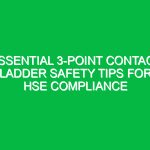Introduction
Hello team! Today, we gather for our Toolbox Talk focused on a critical aspect of our daily operations: Unsafe Conditions in the Workplace. Ensuring a safe Environment is not just about compliance; it’s about protecting ourselves, our colleagues, and maintaining our productivity. In this talk, we’ll delve into what constitutes unsafe conditions, how to identify them, and the practical steps we can take to address these Hazards effectively.
Understanding Unsafe Conditions in the Workplace
Unsafe conditions refer to any situation in the workplace that poses a risk of injury or harm. These could be physical Hazards, organizational shortcomings, or environmental factors. Recognizing these conditions is the first step toward mitigation. Common examples include:
- Slippery floors
- Cluttered workspaces
- Inadequate lighting
- Improper use of equipment
- Blocked emergency exits
Each of these examples can lead to accidents if not addressed promptly. For instance, a simple spill on a floor can lead to serious slip-and-fall incidents, an issue that is all too common in many workplaces. Awareness and proactive measures are essential.
The Importance of Addressing Unsafe Conditions
Addressing unsafe conditions is crucial for several reasons:
- Prevention of Accidents: By identifying and correcting unsafe conditions, we reduce the risk of accidents and injuries.
- Enhancing Productivity: A safe workplace enhances employee morale and productivity. When workers feel safe, they can focus better on their tasks.
- Legal Compliance: Organizations are required to adhere to health and Safety Regulations. Non-compliance can lead to fines and legal repercussions.
- Reducing Costs: Accidents can lead to significant costs related to medical bills, lost workdays, and insurance claims. A proactive Safety culture reduces these financial burdens.
Identifying Unsafe Conditions
Now that we understand the importance of addressing unsafe conditions, let’s discuss how to identify them. Here are some strategies:
1. Regular Inspections
Conducting regular inspections of your work environment is essential. Use checklists to ensure that you cover all areas. Look for:
- Hazards related to equipment
- Environmental factors like temperature and ventilation
- Proper storage and organization of materials
2. Employee Reporting
Encourage open communication among team members. Employees should feel comfortable reporting unsafe conditions without fear of retribution. Set up a system for reporting hazards, and ensure everyone knows how to use it.
3. Training and Awareness
Provide Training sessions that focus on recognizing unsafe conditions. This can empower employees to take action when they spot a potential hazard. For example, during a training session, you might simulate a slip-and-fall scenario and discuss how it could have been avoided.
Best Practices for Addressing Unsafe Conditions
Once you’ve identified unsafe conditions, it’s crucial to address them promptly. Here are some Best Practices to follow:
1. Develop a Safety Action Plan
When an unsafe condition is identified, develop a safety action plan. This should include:
- A detailed description of the hazard
- Immediate corrective actions
- Long-term solutions to prevent recurrence
- Assigning responsibilities for corrective actions
2. Implement Corrective Actions
Take immediate steps to eliminate the hazard. For example, if a floor is wet, ensure it is cleaned and dried promptly, and place warning signs until it is safe. For more complex issues, such as equipment malfunctions, ensure that repairs are completed by qualified personnel.
3. Continuous Monitoring
After addressing a hazard, continue to monitor the situation. Conduct follow-up inspections to ensure that the corrective actions are effective and that no new hazards have emerged.
Real-Life Scenarios
Let’s consider a few hypothetical scenarios to illustrate the importance of addressing unsafe conditions:
Scenario 1: The Wet Floor
Imagine a scenario where a worker spills water in the break room. If it’s not cleaned up immediately, someone could slip and get injured. However, if the team has a procedure in place for reporting spills, such as notifying a supervisor or using a designated spill kit, the risk can be minimized.
Scenario 2: Blocked Emergency Exits
In another scenario, let’s say that several boxes are left in front of an emergency exit. If an emergency were to occur, it could hinder evacuation efforts. Regular inspections and a clear policy on maintaining clear access to exits can prevent such a situation.
Engaging the Team
Now, let’s open the floor for discussion. I’d like to hear your thoughts on the following questions:
- What unsafe conditions have you encountered in your areas of work?
- How do you think we can improve our reporting and communication regarding safety hazards?
- Can anyone share a personal experience where addressing an unsafe condition made a difference?
Your insights are invaluable in creating a safer workplace.
Regulations and Standards
It’s important to understand the regulations that govern Workplace Safety. Organizations must comply with standards set forth by regulatory bodies such as OSHA (Occupational Safety and Health Administration). These regulations mandate the reporting and management of unsafe conditions. Compliance not only protects employees but also shields the organization from legal issues and fines.
Additionally, familiarize yourself with company policies regarding safety. Understanding these policies can help you recognize your responsibilities in maintaining a safe working environment.
Conclusion
To wrap up, addressing unsafe conditions in the workplace is a shared responsibility that requires ongoing attention and action. By identifying hazards, implementing corrective measures, and fostering an open dialogue about safety, we can all contribute to a safer workplace. Remember, safety is not just a priority; it’s a value that we all must embrace.
Thank you for your attention and commitment to maintaining a safe working environment. Let’s continue to look out for one another and ensure that we’re all doing our part to prevent unsafe conditions in the workplace!


